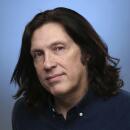Jazz photographer Herman Leonard regroups at 86
- Share via
The home of Herman Leonard is adorned with the rich décor of a man who has seen the world. Hanging on the wall are woven temple offerings from Bali and votive clay tablets from Burma. On a shelf is a damaged metal Buddha he rescued from a fire while stationed in Southeast Asia during World War II. An ancient American sign nearby reads: “Colored Only. No Whites Allowed.”
Just as prominent are artifacts from his love of jazz music, rows of books and CDs and, most preciously, the stacks of elegant photographs he’s taken of musicians since 1948. Leonard is 86 now, and he happily opens up his portfolio to flip through decades of defining images of Duke Ellington, Frank Sinatra, Louis Armstrong, Billie Holiday and Miles Davis, vivid and alive in frames filled with smoky, shimmering light.
“I took advantage of being a photographer to get myself into the clubs, so I could sit in front of Charlie Parker,” he says with a chuckle, explaining his inspiration as a young photographer in New York. “I got to listen to music in person. That enriched me. The money didn’t. And I tried to make images that would satisfy me.”
The market for jazz pictures was modest, just Downbeat and Metronome magazines in the U.S. But he kept turning up at the clubs with his big 4x5 Speed Graphic camera and two battery-powered strobe lights, aiming to capture the ambience of a jazz club. What he documented from his earliest days have remained among the most lasting images of musicians from the last half-century and more: Ellington counting off a beat in silhouette at the piano; a young Tony Bennett embracing a microphone; a pensive Chet Baker reflected in a mirror, years before drugs hardened his features. The pictures are naturalistic and dramatically composed, full of evocative light and shadow.
These are some of the photographs included in “Legends of Jazz Photography,” an exhibition opening Thursday at the Fahey/Klein Gallery in Los Angeles. Leonard’s pictures will hang alongside enduring jazz photographs by the late William Claxton and William Gottlieb. Opening in an adjacent room is a previously scheduled collection of color pictures by rock, jazz and soul photographer Jim Marshall, 74, who died Wednesday. “Herman has lived a full life, and Jim was the same way. They didn’t do anything 50%,” says gallery co-owner David Fahey.
For Leonard, the exhibition is another step in his mission to rebuild his work and legacy in the aftermath of Hurricane Katrina, which flooded his home in New Orleans in 2005, destroying 8,000 prints, a lifetime of work and everything he’d planned on leaving for his children. Fortunately, his 60,000 negatives were safely transported before the storm to the vault of the Ogden Museum.
His house was a block away from Lake Pontchartrain, and Leonard was evacuated 12 hours before Katrina hit. He watched it all on TV from Houston. He moved to Los Angeles at the suggestion of a daughter already based here, and now lives in Studio City.
In a few hours, a documentary crew was coming by, and his friend and frequent photographic subject Lenny Kravitz planned to visit. Leonard has become friends with a few musicians through the years, particularly Quincy Jones and Tony Bennett, and he shed real tears at the deaths of Dizzy Gillespie and Miles Davis.
On his computer , he clicks open a close-up picture of Davis at his final performance, with Jones at the Montreux Jazz Festival in 1991. The look on the fading trumpeter’s face is a mixture of pride and anguish. “Miles was the best photographic subject to me ever, in any category,” he says of the jazzman whom others sometimes found difficult. “It was impossible for me to take a dull or uninteresting photo of this man. What a great subject to have in front of your camera! Duke Ellington was the Beethoven of jazz. Miles was the Picasso.”
The mini Speed Graphic camera he began using 50 years ago is nearby, but Leonard mostly shoots digital pictures now, a new technology he calls “a godsend.” He became fascinated with photography after his older brother gave him a little Box Brownie. He studied photography at Ohio University and apprenticed with the portrait photographer Yousuf Karsh in Ottawa.
He moved to New York and found his greatest subject, but not his only one. In 1958, he moved to Paris, where he sometimes chatted with Henri Cartier-Bresson at the photo lab they both used. He also contributed to Playboy over a period of 15 years. Part of him dreamed of becoming a National Geographic photographer, a desire that led him to seek assignments in Eastern Europe, Afghanistan and Iran. “My true love in photography isn’t jazz,” he admits, “it’s the world.”
Yet music remains the subject for which he’s best known. It’s what brought him to his beloved New Orleans for 15 years. And now in L.A., he is preparing his work to live on after him. He realized years ago his pictures would have life and value far beyond his own amusement after the Smithsonian bought 130 images, some of them now displayed beside glass cases holding Gillespie’s trumpet, an Ellington manuscript. As he speaks, boxes with new prints of various sizes are behind him. “When I leave, my daughter will take over the general overseeing of the business and then it will continue,” he says.
He still listens to jazz every day, but hasn’t found contemporary artists that excite him like the ones he photographed long ago. “I’m still searching,” he says.
More to Read
The biggest entertainment stories
Get our big stories about Hollywood, film, television, music, arts, culture and more right in your inbox as soon as they publish.
You may occasionally receive promotional content from the Los Angeles Times.











